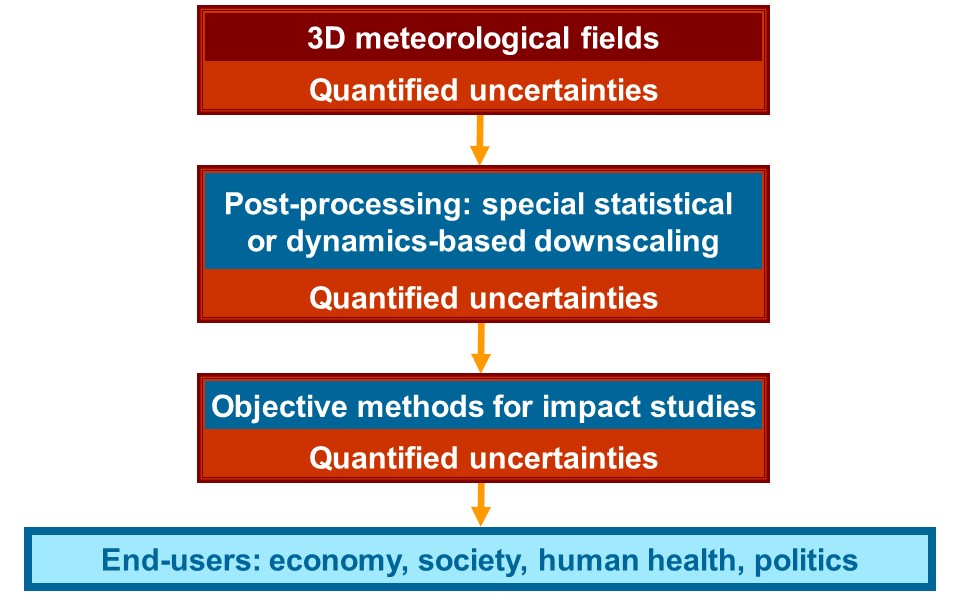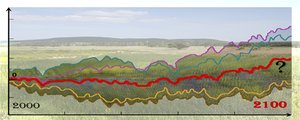Regional climate models (RCMs) provide information about the meteorological aspects of climate change. To prepare targeted and sustainable adaptation strategies, it is indispensable to know the effects induced by meteorological changes in detail. All this requires quantitative impact assessments.
At the Hungarian Meteorological Service (OMSZ), links with the users of RCM data have been continuously sought and co-operations have been established on the same professional basis (Figure 1) since beginning of the climate dynamics activities. The quantitative and detailed meteorological information desired for climate impact studies are ensured by RCM outputs, directly or after some post-processing steps. Climate change affects various sectors (e.g., human health, agricultural production, natural habitats), consequently, climate data users also have diverse needs and preparedness. Therefore, gathering the input data for impact assessments is a multi-step, iterative-consultative process, during which the user requirements are harmonized with the limitations and the possibilities of RCM data. The actual outcomes always reflect the current state-of-the-art in science. For correct understanding of the results, uncertainties in the applied data and methods are indispensable to be considered. Since the projection uncertainties are quantified using a set of model simulations, also impact investigations have to be based on an ensemble of input data. Users and decision makers are supported with trainings and consultations in right interpretation of the results.

Figure 1
Flow-chart about applicability of regional climate model outputs for climate impact studies
Model data of OMSZ were used first in international climate impact studies, while adaptation strategies in Hungary mostly were based on qualitative conclusions or a scenario considered intuitively as most likely. Efforts to provide a consistent, objective basis for climate impact assessments have been started only in the last few years. The National Adaptation Geo-information System reached its operational phase in 2016 to support the climate adaptation strategies and related decision making. The future climate projections of NAGiS are based on outputs of the ALADIN-Climate and RegCM regional climate models (Sábitz et al., 2015, Szépszó et al., 2016).
Our climate model results are used for climate impact assessments in several sectors, moreover, Hungarian Meteorological Service is also involved in impact research. A few examples are as follows:
- Future changes in water balance of Lake Balaton (Nováky et al., 2016);
- Climate change impacts on groundwater (Kovács et al., 2015) and drinking water (Rotárné Szalkai et al., 2015);
- Effects of climate change on natural habitats (Somodi et al., 2016);
- Climate change impacts on agriculture, biomass yield, forestry – AGRATéR project (in Hungarian);
- Climate change impacts on human health, road accidents and tourism – KRIGiS project;
- Urban impacts of climate change.
References
Kovács A., Szőcs T., Tóth Gy., Marton A., Kun É., Kerékgyártó T., 2015: Modelling of ground water’s climate sensitivity in a NAGiS (in Hungarian). Research report. [PDF]
Nováky B., Varga Gy., Homolya E., Szépszó G., Csorvási A., 2016: Climate change impacts on water budget of Lake Balaton (in Hungarian). Research report. [PDF]
Rotárné Szalkai Á., Homolya E., Selmeczi P., 2015: Climate change impacts on drinking water (in Hungarian). Research report. [PDF]
Sábitz, J., Szépszó, G., Zsebeházi, G., Szabó, P., Illy, T., Bartholy, J., Pieczka, I., Pongrácz, R., 2015: Application of indicators based on regional climate model results. Report summary. [PDF]
Somodi I., Bede-Fazekas Á., Lepesi N., Czúcz B., 2016: Climate vulnerability assessment of natural ecosystems (in Hungarian). Research report. [PDF]
Szépszó G., Illy T., Szabó P., 2016: Post-processing of regional climate model results to prepare the climate parameters for NAGiS (in Hungarian). Research report. [PDF]











